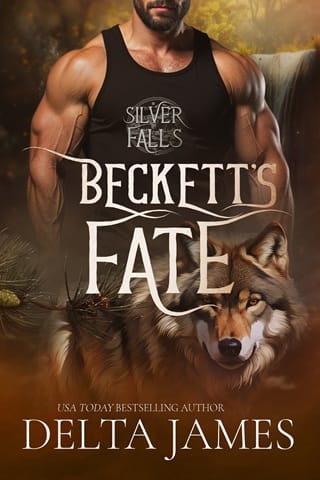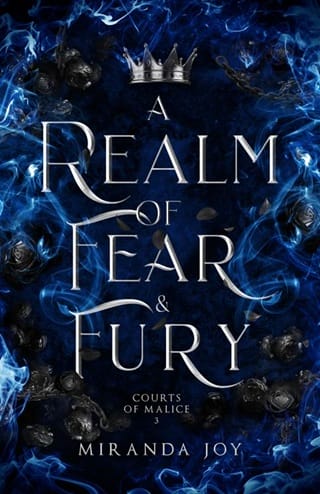Chapter 14
14
Not long after, in a replay of the night before, Keone and I ascended the stairs to the Hales’ Victorian home on the outskirts of Hana. I hadn’t had anything of my own to wear after my shower, so I had on a T-shirt and basketball shorts belonging to Keone. He smiled, eyeing me in the baggy clothing.
“You make those old gym shorts look sexy,” he whispered in my ear as we stood in front of the beveled glass front door.
I could feel my cheeks warm as the door opened on Dr. Hale. He also wore an old tee and basketball shorts; this time his hair was disordered as if he’d run a hand through it. His glasses were atilt on his wide nose. “Thank goodness you’re here,” he said, ushering us inside. The scent of old books and leather hit us as we entered, along with a hint of last night’s baking. “Come this way.”
Dr. Hale led us to his office, a cluttered space filled with stacks of documents, Hawaiian artifacts, and what looked like the entire contents of a small library. He gestured for us to sit in a couple of comfy chairs facing his desk as he rummaged through a pile of papers on the surface.
“I’ve made a discovery that could change everything we thought we knew about the Queen’s ornament,” he said, his voice tinged with excitement and a hint of worry.
Keone leaned forward, his knee brushing mine. “What did you find, Dr. Hale?”
The historian pulled out an old, yellowed document, handling it with reverence. “This is a letter from Queen Lili?uokalani to her advisor, dated 1892, just before the overthrow of the Hawaiian monarchy.”
My heart raced as I realized the significance. “That’s right around the time the ornaments were gifted to the Pahinui and Namolo families.”
Dr. Hale nodded gravely. “Exactly. But according to this letter, the ornaments weren’t a gift at all. They were a pair of sacred emblems to be entrusted to the Queen’s favorite guardsmen for safekeeping during the tumultuous period of the overthrow.”
Keone’s sharp intake of breath mirrored my own surprise. “But that means . . .”
“It means the ornaments were never meant to be kept,” I finished, the implications hitting me. “They were meant to be protected until they could be returned to their rightful place.”
Dr. Hale spread his hands. “Precisely. The families were meant to be the ornaments’ guardians, not their owners. And there’s more.” He pulled out another document, this one a more recent legal paper. “I found this in the Office of Hawaiian Affairs records. It seems that in 1960, the Pahinui family tried to return their ornament to the Office of Hawaiian Affairs but it was blocked by the Namolos, who claimed ownership.”
A heavy silence fell over the room as we absorbed the magnitude of this revelation. The ornament, far from being a simple family heirloom or valuable antique, was a piece of Hawaiian history caught in a complex web of ownership, duty, and cultural significance.
“The Bishop Museum,” Keone said suddenly, standing up. “That’s where it needs to go. All the royal artifacts, the sacred items from the monarchy—that’s where they’re preserved.”
Dr. Hale nodded slowly, adjusting his glasses. “The Bishop Museum does house the largest collection of Hawaiian royal artifacts. They have the expertise, the security, and most importantly, the cultural authority to protect such items.”
I stood up too, my mind racing. “If we can convince Artie to donate it to the Bishop Museum voluntarily . . .” I paused, remembering my earlier conversation with Leilani. “This could be the perfect solution. We could have a ceremony that brings everyone together.”
“A pono solution,” Keone agreed, using the Hawaiian word for righteousness and balance. “But will Artie agree?”
“We have to try,” I said, gathering myself. “Dr. Hale, may we take these documents? Artie can’t see them, but if Opal reads them to him . . .”
The historian carefully placed the papers in a clear plastic protective sleeve. “Of course. But handle them with care and return them when you’re done. I’ll be looking forward to hearing the outcome, regardless.”
The drive to the general store was quiet. Both Keone and I were lost in thought once I’d brought him up to speed on my meeting with Leilani. Darkness made the lights on the tree inside the Post Office bright when we turned into the lot.
“Do you think Leilani took the ornament?” he asked at last.
“Possibly, or she knows who did. I don’t actually care as long as it’s returned in time for us to donate it at the event,” I said.
“Agreed.”
We pulled into the empty parking lot. All the lights were out but the sparkling holiday ones.
“Store’s closed. Let’s go to the Pahinuis’ residence front door.” I led the way, holding the letters from Dr. Hale in their archival sleeve. Keone caught my hand and gave it a squeeze as we navigated a row of recessed beach stones around the side of the building to the Pahinuis’ private entrance.
“Coming!” Opal called when I knocked. She opened the door, still wearing her festive outfit from work. “We’re just getting some food on the table. Want to join us?”
“We’d love that,” Keone said. My stomach gave a loud rumble of agreement with this idea.
“I brought you cookies from Mrs. Hale,” I said, handing over the tin the professor had slipped into my hands, along with the letters. “But are you sure you have enough supper for us?”
“It’s homemade chili that Artie was cooking all day in the Crock-Pot,” Opal said.“ There’s a ton of it.” Her gold tassels flashed as she walked, and the year-old kittens pounced on her from the shadows beneath the table. “Stop it, you rascals! Artie, Kat and Keone are here for dinner.”
“I heard. There was a reason I made an extra large pot,” Artie said. He was a little psychic, I’d discovered. “Visiting twice in one day, Kat? Must be important.”
“It is,” I said, pulling up a chair. “We’ve just come from Dr. Hale’s, and there’s something you need to know about the ornament. About its true history.”
“I’ll dish up dinner after we hear this,” Opal said. Opal sat down next to her husband as Keone explained what we’d discovered. I watched Artie’s face as she read the Queen’s letter aloud, his expression shifting from skepticism to surprise to something deeper, a kind of understanding.
“A sacred trust,” he murmured when she finished. “Not a gift at all.”
“The Bishop Museum has an entire section dedicated to Queen Lili?uokalani’s personal effects,” Keone said gently. “Items she trusted are preserved there for future generations of Hawaiian people.”
“If you were to donate it,” I added, “it wouldn’t be giving up your family’s connection to the ornament. It would be fulfilling your great-grandfather’s responsibility as the ornament’s guardian.”
Artie’s unseeing eyes were bright with emotion. “All these years, I thought . . .” He swallowed hard. “I thought it was about ownership, about our family’s right to keep it. But it was never about that, was it? It was about protection. About doing what’s pono .”
Opal squeezed his hand. “What are you thinking, love?”
“I’m thinking,” he said slowly, “that it’s time for the ornament to go home.” He turned his face toward where Keone and I sat. “Will you help me arrange it? A proper ceremony, with all the cultural protocols? The ornament deserves that much.”
“Of course,” Keone said warmly. “And Artie? This is a good thing you’re doing. A very good thing.”
“Not only that, but we can also still have the ornament as a centerpiece of the auction,” I said. “I have to speak to Elle and Aunt Fae about how to do this, but we can still have folks donate to it in the name of the Bishop Museum. Leilani at the Hana History Museum might be disappointed, but it’s meant for a larger public.”
“Now, if only you could find it,” Artie said.
“I feel confident that, when we get this information out, whoever has the ornament will make it reappear,” I said.
“I hope you’re right. And since you need to talk to Elle and Aunt Fae about the plan anyway, why don’t I call them up and invite them over for chili? There’s plenty for all.” Opal got up and headed for the old wall phone with its long, curly cord.
As we left the store, the night air soft with the scents of plumeria and the sea, I hoped we’d set something important in motion. Somewhere, someone was holding onto that ornament, thinking they were protecting it. Soon, they’d know it was finally going where it truly belonged. Elle was already on the phone with the Maui News and Maui Now public information bulletins. Our carefully worded message about the ornament’s provenance and Artie’s plan to donate it to the Bishop Museum was going out all over the island by formal communication, and also via ‘coconut wireless’ word-of-mouth.
The moon rose over Ohia Bay, full and bright, as if approving of the path we’d chosen. Now we had to wait and see who would step forward to help the ornament complete its long journey home.
 Fullepub
Fullepub 



